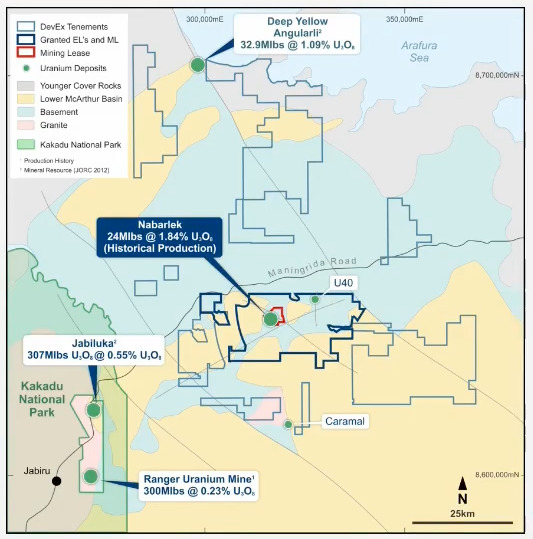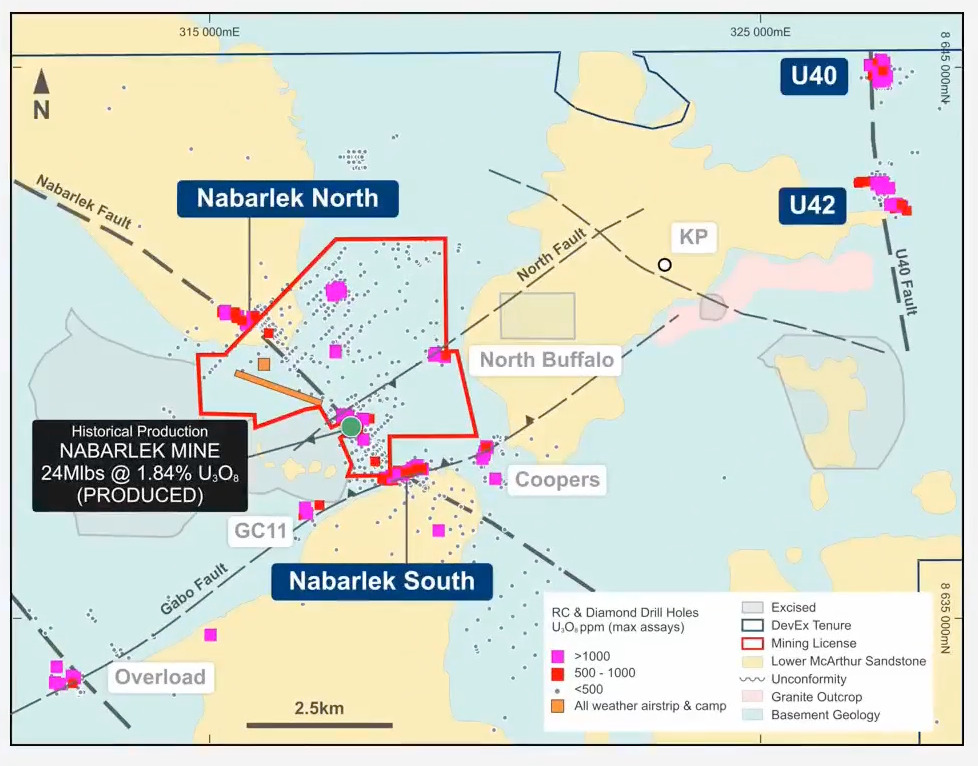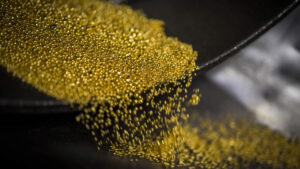The price is right: These uranium, gold and copper explorers are scaling the value curve at the perfect time

Pic via Getty Images
It’s not just AFL teams gathering round Adelaide this week, with some of Australia’s most exciting up and coming miners in town for the inaugural Resources Rising Stars ‘Gather Round’ event at the National Wine Centre yesterday.
Turns out my Freo Dockers weren’t the hottest ticket in town as resources executives across a gamut of commodities took to the podium to present insights into their flagship projects and upcoming plans.
The mood was abuzz with positivity amongst investors, too, with gold prices soaring to new heights, passing the US$2,300-mark yesterday morning after a strong signal from Federal Reserve Chair Jerome Powell that policymakers will wait for clearer signs of lower inflation before cutting interest rates.
Uranium miners get drilling
Uranium miners kicked the day off with DevEx (ASX:DEV) managing director Brendan Bradley painting a compelling picture of its prized package of tenements in the NT’s Alligator Rivers uranium province, one of only a few ASX uranium explorers with projects in Australia.
More than 600Mlbs of uranium have either been mined or defined in current resources across the Alligator Rivers province, Bradley told conference goers, with a number of those projects surrounding DEV’s tenure including the 307Mlbs Jabiluka deposit, owned by Energy Resources of Australia (ASX:ERA).

The Tim-Goyder backed explorer is on the hunt for a deposit similar to the mined-out historic Nabarlek deposit or the nearby world-class Ranger mine, which produced 300Mlbs @ 0.23% U3O8 over 45 years, after purchasing the mine in 2008.
Its focus is the region around the Nabarlek mine, which historically produced 24Mlbs @ 1.84% U308.

“At the U40 prospect, we are homing in on a Camico-DevEx JV intercept of 6m @ 7% from 2010 just prior to the downturn in the industry with the Fukushima disaster,” Bradley said.
Two zones of uranium mineralisation have been identified at U40, pointing to the possibility that a +500m uranium system could be emerging deep underground.
Meanwhile, ground geophysics work is helping the company identify multiple structural targets surrounding the Nabarlek mine along the Nabarlek Fault.
“It’s providing us with a lot of context for what we want to do inside the mining lease,” he said.
“Our major shareholder, Tim Goyder, is all about drilling, that’s the message he likes to deliver and that’s his success story so far – making discoveries.
“The way you do that is you drill a lot of holes, to drill a lot of holes you need to have support and you need to have good cash backing,” Bradley said.
DevEx has about ~$20m in the bank to maintain the exploration momentum at Nabarlek this year with drilling set to take off next month.
On the cusp of production
But not all uranium pounds are created equal, and while there’s many uranium focused companies around the world, most of those won’t get into production – as we saw in the last cycle.
This makes Boss Energy’s (ASX:BOE) Honeymoon mine, which is destined to become South Australia’s third producing uranium project in South Australia and Australia’s first in the last decade to come into production, a rare asset in the current resources cycle.
Honeymoon is currently two weeks away from producing its first drum of uranium as prices reach 16-year highs.
From a growth perspective, BOE managing director Duncan Craib said the company has its own satellite deposits (Goulds Dam and Jasons) which it is looking to put mining licences on to incorporate into the upcoming production plan.
“The current resource that the project sits on, 36Mlbs is what the current mine life is based on which gives you 10 to 12 years but by bringing these satellite deposits on, we’re to build out our production profile and grow it from a 2.5Mlbs nameplate capacity to up to 3.3Mlbs per annum.”
Uranium’s structural supply deficit, set to take place over the next four years with or without Russian supply, only spells opportunity ahead.
Craib believes uranium prices in the next two to three years will surge even higher.
“That’s where Boss want to be, this is the highest uranium price going into a new cycle, it’s a wonderful investment proposition and we want to take advantage of that.”
To date, the soon-to-be-producer has raised $420m in the last seven years, with a healthy $265m sitting on the company’s balance sheet right now.
Second quarter – gold stocks on the rise
One company flying the flag for the gold sector was growth stock Spartan Resources (ASX:SPR), a company who at its core represents the classic tale of a previously struggling explorer that is now delivering rewards to loyal shareholders.
Armed with a fresh exploration target for Never Never of 1.6–1.9Moz of contained gold and a 952,9000z resource, the company is working towards restarting mine operations at Dalgaranga after two close calls as a low-grade miner.
Five drill rigs are currently on the go at the site carrying out a 28,500m drilling campaign in WA’s Murchison region where recent hits include up to 15.85m @ 20.23g/t gold for the growing Never Never deposit.
“We’re drilling to de-risk, we’re in a blessed position and as geologists we’re pretty excited,” SPR managing director Simon Lawson told delegates yesterday.
“Many people continue to ask me if we’re a target to be taken out, we just focus on what we can control and what we can control is where we drill the holes.
“We’re going to walk everybody down the path of production.”
Silver prices broke through $US27/oz on Thursday for a tidy 13% gain since the start of the year which set the scene for Sun Silver.
The company took the stage before half time to highlight its Maverick Springs property in Nevada, US, home to an inferred resource of 125,421,000 tonnes at a silver equivalent grade of 72.4g/t for 292Moz silver equivalent.
It hopes to list on the ASX in late May and kick off deep drilling soon after to further expand and upgrade the large-scale resource.
“We’re in a great location, Nevada is a notable mining jurisdiction, attributing to about 75% of the USA’s silver and gold production,” Sun Silver executive director Gerard O’Donovan said.
O’Donovan spent six years at Pilbara Minerals (ASX:PLS) during the development, commissioning and ramp-up phases as well as a few years at Rio Tinto’s Winu copper gold project.
Copper bulls
Copper prices climbed to new ground yesterday, opening at US$4.13 per pound, up 1.04% from the previous days price and up 6.69% since the beginning of the year, which provided a nice investment case for Capella Metals.
Set to list under the code ‘CAP’, the company outlined its growth prospects at the Surprise copper-gold mine in QLD, which shares strong similarities to nearby, large copper-gold deposits like Evolution Mining’s Ernest Henry deposit.
Previous drilling returned shallow results including 23.77m @ 4.67% copper from 51m as the project operated through various stages throughout the 20 Century.
Following its listing, Capella plans to quickly define a resource and progress exploration over a series of high priority targets within one of the largest land holdings in the Mount Isa region.
Over in NSW, Legacy Minerals (ASX:LGM) is targeting both gold and copper with a portfolio of projects leveraged to both opportunities.
The company is looking to launch drilling campaigns across its multiple projects, starting first with Black Range in the Lachlan Fold Belt where drilling will target a large gold-silver in soil anomaly in early April.
Black Range is an extensive low-sulphidation epithermal system with limited historical exploration.
Later in Q2 2024, LGM plans to carry out drilling at the Fontenoy project near the Young, NSW where partner Earth AI has used artificial intelligence-guided exploration to discover magmatic PGE-nickel-copper mineralisation.
At Stockhead we tell it like it is. While Spartan Resources and Legacy Minerals are Stockhead advertisers, they did not sponsor this article.

UNLOCK INSIGHTS
Discover the untold stories of emerging ASX stocks.
Daily news and expert analysis, it's free to subscribe.
By proceeding, you confirm you understand that we handle personal information in accordance with our Privacy Policy.








